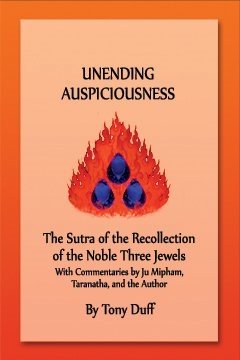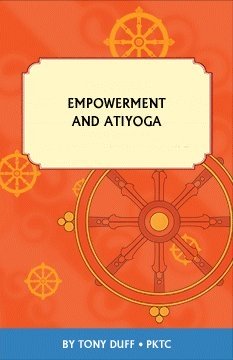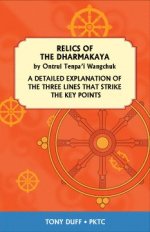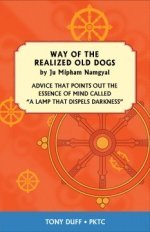The View and Practice According to the Sutras
The next step is to develop an understanding of the view at the sutra level. The Buddha himself stated that he taught the sutra teachings in three, progressive steps known as “the three turnings of the wheel of dharma”. The view and practice of the first turning of the wheel corresponds to the the path known as “The Lesser Vehicle”. It contains teachings on renunciation followed by teachings on the absence of a personal self which, when practised, lead to a personal liberation. People who are following the Tibetan Buddhist path will usually follow the teachings on renunciation but not practice the teachings that lead to a mere personal liberation. They will pay close attention to the meaning of refuge and the good qualities of the Three Jewels as shown in the book mentioned above:
Taking refuge is a common basis for all of the Buddha’s teaching. As well as that, the teachings of the Abhidharma are basic to all of the higher teachings, so it is necessary to learn certain parts of the Abhidharma teachings. The Buddha himself said that there were six topics of all the Abhidharma topics that all of his followers should learn. With that instruction as a basis, Zhan Ga Rinpoche compiled a text that clearly sets out these six topics, making it easy to learn them:

The next step is to arouse the enlightenment mind or bodhichitta, and then to practise the actions—called paramita—of the bodhisatva path. One of the most popular texts for learning to do that is Shantideva’s Entering the Bodhisatva Conduct. There are several translations of this text available. The ones made directly from the Sanskrit are usually more accurate, for example, the translation made many years ago by Marion Matics is excellent. There are often points in the existing translations from Tibetan of this text where the intended meaning does not come through clearly. Padma Karpo of the Drukpa Kagyu wrote an excellent commentary on Shantideva’s text which explains each word or phrase of the original, adding just enough so that the original meaning becomes very clear:

The next step is to pay close attention to the meaning of emptiness. That is because coursing in emptiness is the basis for all of a bodhisatva’s conduct. As a preliminary to that, it is necessary to gain a clear understanding of the two truths. For that, we have a short but very clear presentation of the two truths by Dza Patrul:

For the teachings on emptiness, it has to be understood that the Buddha’s teachings on emptiness are found in both the second and third turnings of the wheel of dharma. Tibetan Buddhist schools have differences of opinion over how the teachings on emptiness are presented within the second and third three turnings of the wheel. The Gelugpa and much of the Sakya school maintain that the ultimate teachings of emptiness are to be found in the second turning of the wheel, in the teachings most commonly called Madhyamaka or the Middle Way. For those schools, the ultimate view of the bodhisatva and the way to practise that view are found in the Prajnaparamita teachings of the second turning of the wheel. However, for the other Tibetan Buddhist schools—and note that this is the majority of them—such as the Kagyu, Nyingma, and Jonang schools, the ultimate view of the bodhisatva and the way to practise that is found in the teachings of the third turning of the wheel. It is noteworthy that the Buddha himself says in one of the third turning of the wheel sutras that he did turn the wheel of dharma in a progressive sequence of increasingly profound teachings and that his ultimate sutra teaching was given in the third turning of the wheel.
Now the view of the Gelugpa school and much of the Sakya school that the teaching of the Middle Way is the ultimate teaching has become very well known and popular amongst non-Tibetans. The view of the Kagyu, Nyingma, and Jonang that the teachings of the third turning contain the ultimate teaching of the sutras is less well known. In general, the study program here follows the latter understanding. In particular, because there has been so little practical material presented from the understanding that the ultimate teaching is contained in the third turning of the wheel, there is a strong emphasis on texts which very clearly explain that approach. Note that the general name used in the Kagyu, Nyingma, and Jonang schools for that approach is “emptiness of other” or “Other Emptiness” (Tib. gzhan stong or zhantong and note that this is mostly mis-spelled these days as shentong). What that really means is the ultimate presentation of the Buddha’s teachings in which non-dual wisdom of is shown.
PKTC has put a special emphasis on preparing texts on the Buddha’s teachings of the non-dual view as found in the third turning of the wheel. The following texts are invaluable for understanding that view and the practice of it as well. There is a very important point here, which is that it has often been thought that Other Emptiness is purely a philosophical view, one that only entails polemic argument. In fact, it is a very practical view and there is a very distinct style of meditation practice that goes with it. It is also very important to note that the true view of Other Emptiness does not reject the Middle Way view and practice, usually referred to as “emptiness of self” or “Self Emptiness”. Rather, it incorporates the view of emptiness of a self and the practice of Middle Way meditation into the overall view and practice of Other Emptiness. In this way, a person who follows the view and practice of Other Emptiness actually accomplishes the entire bodhisatva teachings contained in the second and third turnings of the wheel. The following selection of key texts from the Tibetan Buddhist tradition is particularly important because it not only shows the view of Other Emptiness as one containing the teachings of both second and third turnings of the wheel, but also shows that Other Emptiness is not dry philosophy, but a very practical teaching. The selection even includes an instruction manual on the practice of Other Emptiness meditation.
First, there are three sutras from the third turning of the wheel which show the Other Emptiness teaching of the Buddha:



One of the main champions in India of what later became known in Tibet as Other Emptiness was the Indian master Maitripa. Therefore, the next book to study is:

This book contains the most important writings of Maitripa concerning the view and practice of it. It contains a complete commentary to each of Maitripa’s several texts, written by the author so that the main points being made by Maitripa can be understood. A free sampler of a few of the teachings in this book is available on the free texts pages. These teachings are particularly treasured by all Kagyu followers because they are the source from which the entire Kagyu view is derived. Anyone learning the view of the Kagyu tradition should read these texts.
In general, we can say that the Nyingma and Kagyu view is exactly the same at the sutra level. One of the very popular texts on Other Emptiness on the Nyingma side is the very famous text by Ju Mipham which lays out the Other Emptiness view and the debates around it very clearly:

After reading the texts contained in those books, there are several more books that clearly present the Other Emptiness view, each one from a different perspective. First, there is Milarepa’s most important song of the view An Authentic Expression of the view of the Middle Way in a book with long explanations of that and another important song of Milarepa on the view. Importantly, this book contains an introduction to the Other Emptiness view that is particularly clear and which clears away many mis-conceptions concerning Other Emptiness in a very easy-to-understand way. This book was written for practitioners as well as scholars and both will benefit:

Next is a text by the second Drukchen of the Drukpa Kagyu school, which has a complete overview of the Kagyu view and practice. Again, the author provides a long introduction that clearly shows the meaning of Other Emptiness and clears away mis-conceptions about it in an easy-to-understand way. One of the very interesting things about this book is that it joins the sutra understanding of Other Emptiness to the non-dual view of the Kalachakra tantra as understood in the Kagyu school. The text features debates between the Second Drukchen and Gelugpa scholars who came to debate with him, in their attempts to prove that the second turning of the wheel is where the ultimate teaching is to be found. The second Drukchen’s replies show very clearly how the ultimate view taught in the sutras by the Buddha is in fact the view of tantras:

Finally, there is Lama Tony’s magnum opus. This is a thorough exposition of the meaning of the other empty, non-dual teachings of the Buddha, explained in a way that has not been seen before in books on Other Emptiness:

![]()









































